"Cherishing Little Steps - A Haven for Baby and Family Journeys"
Maximizing Car Safety for Kids
Do you know that maximizing car safety for kids goes beyond just buckling them up? There are many factors to consider when it comes to keeping your precious little ones safe on the road. From choosing the right car seat to ensuring a secure fit, every step matters.
In this guide, we will explore the ins and outs of car safety for kids, providing you with essential tips and information. Discover the importance of proper car seat selection, understanding seat belt laws, and age-appropriate restraint systems.
Learn about common mistakes to avoid and the significance of regular car seat inspections. With our guidance, you can ensure that your child’s safety is always a top priority while traveling.
Key Takeaways
- Carefully select the appropriate car seat for maximum safety.
- Follow manufacturer’s instructions for proper installation.
- Use age-appropriate restraint systems for optimal protection.
- Regularly inspect and maintain the car seat for a secure fit.
Importance of Car Seat Selection
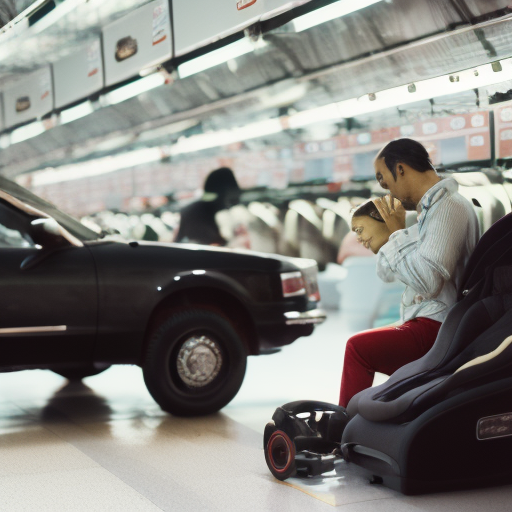
To ensure the utmost safety for your child in the car, it’s crucial that you carefully select the appropriate car seat. When it comes to car seat installation, following the manufacturer’s instructions is of utmost importance. Make sure to read the manual thoroughly and understand how to properly secure the car seat in your vehicle.
The seat belt plays a vital role in keeping your child safe, so it’s essential to ensure that it’s used correctly. Always buckle the seat belt securely and adjust it to fit snugly across your child’s body. In addition, make sure that the seat belt isn’t twisted and that it’s locked in place. Regularly check the seat belt for any signs of wear or damage, as this can compromise its effectiveness in the event of an accident.
Proper Installation of Car Seats
Ensure your child’s safety in the car by properly installing their car seat. The correct installation of a car seat is crucial to protect your child in case of an accident. Follow these car seat installation tips to ensure a secure fit and avoid common car seat installation mistakes.
First, read the car seat manual thoroughly before installation. It provides essential information on how to correctly install the seat in your specific vehicle. Additionally, always use the LATCH system or seat belt to secure the car seat, but never both at the same time.
Next, make sure the car seat is tightly secured. There should be minimal movement when you wiggle the seat. If the seat isn’t secure, it can increase the risk of injury during a crash. Also, ensure that the harness straps are properly adjusted and snug against your child’s body. This will prevent your child from moving around and minimize the risk of ejection.
Lastly, avoid common car seat installation mistakes. Some of these include using expired car seats, not using the correct seat for your child’s age and weight, and not placing the car seat at the correct angle. It’s important to address these mistakes to maximize your child’s safety while traveling.
Understanding Seat Belt Laws
- Familiarize yourself with the specific seat belt laws in your state to ensure compliance and maximize your child’s safety while traveling. Understanding seat belt laws is crucial for protecting your child in the car. According to seat belt statistics, wearing a seat belt reduces the risk of fatal injury by 45% for front seat occupants and by 60% for rear seat occupants. It’s important to know that seat belt laws vary from state to state. Some states require all passengers, regardless of age, to wear a seat belt, while others have specific age and height requirements for children. To stay informed, you can visit your state’s department of motor vehicles website or consult with local law enforcement.
Additionally, it’s essential to be aware of car seat expiration dates. Car seats have an expiration date stamped on them, usually between 6 to 10 years from the date of manufacture. This is because car seat technology evolves, and older seats may not provide the same level of safety. Regularly checking the expiration date and replacing the car seat when necessary is crucial for your child’s safety.
Familiarizing yourself with seat belt laws and ensuring your child’s car seat isn’t expired will help maximize their safety and give you peace of mind while traveling.
Age-Appropriate Restraint Systems
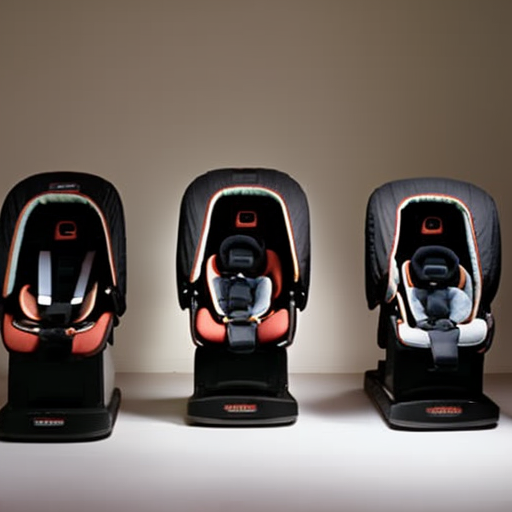
Make sure your child is properly secured in an age-appropriate restraint system to maximize their safety while traveling in a car. Age-appropriate restraints are crucial for protecting your child in the event of a crash. Following car seat guidelines is essential to ensure that your child is using the right type of restraint at each stage of their development.
For infants and toddlers up to two years old, a rear-facing car seat is recommended. This position provides optimal protection for their fragile neck and spine. Once your child outgrows the rear-facing seat, they can transition to a forward-facing car seat with a harness. This type of restraint system keeps your child securely in place during sudden stops or collisions.
As your child grows older and taller, a booster seat becomes necessary. Booster seats ensure that the vehicle’s seat belt fits correctly across your child’s body, preventing injuries in the event of a crash. It’s important to note that children should continue to use a booster seat until they’re at least 4 feet 9 inches tall and between 8 and 12 years old.
Remember that age-appropriate restraint systems are designed to provide the best protection for your child. By following car seat guidelines and using the appropriate restraints, you can significantly reduce the risk of injury in the event of a car accident.
Always prioritize your child’s safety by ensuring they’re properly secured in the right restraint system for their age and size.
Safety Tips for Infant Car Seats
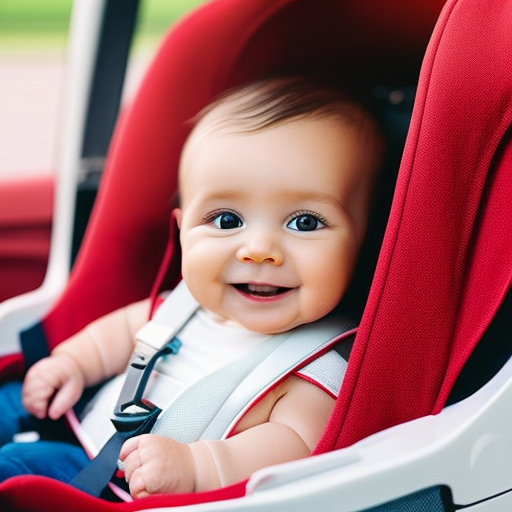
When traveling with an infant, it’s important to properly secure them in an age-appropriate rear-facing car seat. Infant car seat installation requires attention to detail to ensure maximum safety for your little one.
First, make sure the car seat is installed correctly. Follow the manufacturer’s instructions carefully, and use the vehicle’s seat belt or the lower anchors and tethers for children (LATCH) system to secure the seat. Ensure that the seat is tightly secured and doesn’t move more than an inch in any direction.
Proper infant car seat usage is crucial for your child’s safety. Always buckle your baby into the car seat, making sure the harness straps are snug and the chest clip is at armpit level. Avoid bulky clothing that can interfere with the harness’s effectiveness. Position the harness straps at or below your baby’s shoulders to keep them secure in the event of a crash.
Regularly check the car seat for any signs of wear and tear, and replace it if necessary. Also, keep an eye on the weight and height limits specified by the manufacturer to ensure that your child continues to fit properly in the seat.
Tips for Rear-Facing Car Seats
To maximize car safety for your child, it’s essential to follow these tips for rear-facing car seats. Proper installation is crucial to ensure your child’s safety. Start by reading the car seat manual and your vehicle’s manual thoroughly. This will guide you in securely installing the car seat in the rear-facing position. Make sure the seat is tightly secured, with minimal movement. You can use either the vehicle’s seat belt or the LATCH system, but never use both simultaneously.
Once the car seat is installed, it’s important to adjust the straps correctly. The shoulder straps should be threaded through the slots at or below your child’s shoulders. The straps should be snug, with no slack. The chest clip should be positioned at the armpit level, ensuring it isn’t too high or too low.
Regularly check the car seat’s straps to ensure they remain tight and properly adjusted. Straps can loosen over time, so it’s essential to conduct routine checks.
Transitioning to Forward-Facing Car Seats
Once your child has outgrown their rear-facing car seat, it’s time to transition to a forward-facing car seat for optimal car safety. This transition can be both exciting and nerve-wracking for parents, but with the right tips, you can ensure a smooth and secure ride for your little one.
Here are some transitioning tips to guide you through this important milestone:
-
Choose the right car seat: Look for a forward-facing car seat that meets the height and weight requirements for your child. Make sure it’s installed correctly and securely in your vehicle.
-
Follow the manufacturer’s guidelines: Read the manual carefully and follow the instructions for installing and using the car seat. This will ensure that your child is properly protected.
-
Gradual transition: If possible, extend rear-facing as long as possible before transitioning to a forward-facing seat. The benefits of extended rear-facing include better protection for the head, neck, and spine.
Making the switch to a forward-facing car seat is a significant step in your child’s safety journey. By following these transitioning tips and considering the benefits of extended rear-facing, you can provide your child with the best possible protection while on the road.
Boosters and Belt-Positioning Devices
Ensure your child’s safety in the car by using boosters and belt-positioning devices. Boosters and harnesses are essential tools for keeping your child secure and protected while traveling. They’re designed to elevate your child to the correct height, ensuring that the vehicle’s seat belt fits properly across their lap and shoulder. Boosters and belt-positioning devices work by positioning the seat belt across the strongest parts of your child’s body, distributing the force of a crash more effectively and reducing the risk of injury.
When choosing a booster or belt-positioning device, it’s important to consider car seat safety standards. Look for products that meet or exceed federal safety regulations. Check for labels indicating compliance with the National Highway Traffic Safety Administration’s standards.
Remember that boosters and belt-positioning devices aren’t suitable for all children. Each child’s development and height vary, so it’s crucial to follow the manufacturer’s guidelines regarding age, weight, and height recommendations. Additionally, always ensure that the booster or belt-positioning device is properly installed and securely fastened in the vehicle.
Common Car Seat Mistakes to Avoid
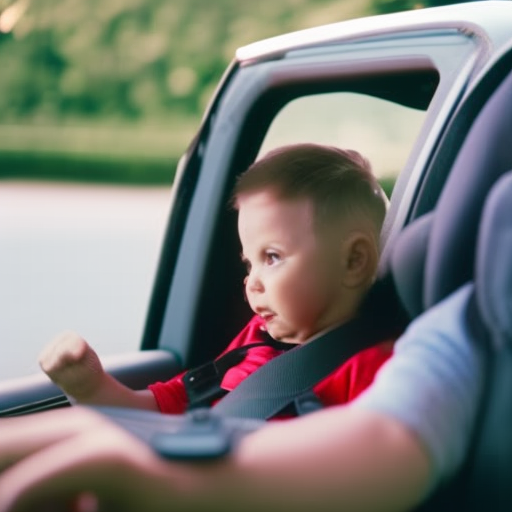
When it comes to maximizing car safety for kids, it’s important to be aware of common car seat mistakes to avoid. By following proper car seat safety guidelines, you can ensure the utmost protection for your little ones. Here are some common car seat mistakes to steer clear of:
-
Incorrect installation: Improperly installing the car seat is a grave mistake that could put your child at risk. Always refer to the car seat manufacturer’s instructions and the vehicle’s manual to ensure correct installation.
-
Wrong seat for the age and size: Using the wrong car seat for your child’s age and size can compromise their safety. Make sure to choose a car seat that’s appropriate for your child’s height and weight, and follow the guidelines set by the car seat manufacturer.
-
Loose harness straps: Loose harness straps can be dangerous as they won’t properly secure your child in the event of a crash. Ensure that the harness straps are snug and fit snugly against your child’s body, with no slack.
Ensuring a Secure Fit for Car Seats

To maximize car safety for your kids, it is crucial to ensure a secure fit for their car seats. Proper installation is key to keeping your little ones safe on the road. Unfortunately, many parents make common installation mistakes that can compromise the effectiveness of the car seat. Let’s take a look at some of these mistakes and how to avoid them.
| Common Installation Mistakes | How to Ensure Proper Installation |
|---|---|
| Loose installation | Follow the manufacturer’s instructions carefully and use the appropriate installation method for your car seat. Make sure the seat is tightly secured and does not move more than an inch from side to side or front to back. |
| Incorrect recline angle | Check the recline indicator on the car seat to ensure that it is at the correct angle. Newborns and infants should have a more reclined position, while older children can sit more upright. |
| Improper use of seat belts | Use the seat belt or LATCH system correctly to secure the car seat. Ensure that the seat belt is threaded through the correct belt path and is locked in place. Double-check that the seat belt is not twisted and is securely fastened. |
Importance of Regular Car Seat Inspections
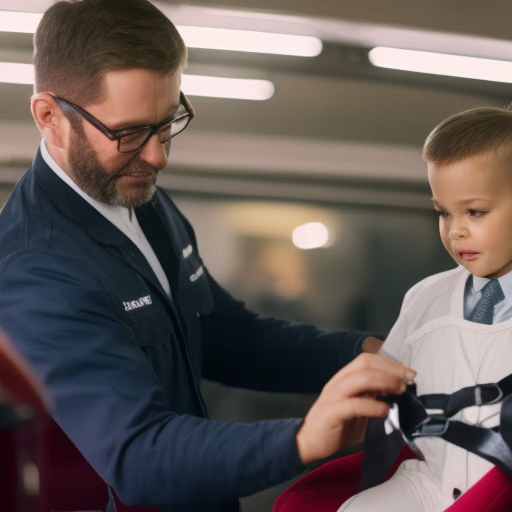
Regular car seat inspections are essential to ensure the ongoing safety of your child while traveling in a vehicle. By regularly maintaining and inspecting your child’s car seat, you can have peace of mind knowing that they’re protected in the event of an accident.
Here are some key reasons why regular car seat inspections are crucial:
-
Safety Assurance: Professional car seat inspections provide a thorough evaluation of your child’s car seat, guaranteeing that it meets the necessary safety standards. This ensures that your child is protected to the fullest extent while on the road.
-
Proper Installation: Car seat maintenance includes checking the installation of the seat to ensure it’s correctly installed in your vehicle. Professional inspections can help identify any installation errors and rectify them promptly, ensuring optimal safety for your child.
-
Peace of Mind: Regular inspections offer peace of mind, knowing that your child’s car seat is in top condition. This can alleviate anxiety and allow you to focus on enjoying your journey without worrying about their safety.
Don’t underestimate the benefits of professional car seat inspections. They provide an added layer of protection for your child, giving you the confidence to travel safely. Make it a priority to schedule regular inspections to ensure your child’s car seat is in the best possible condition at all times.
Safety Tips for Car Travel With Older Children
If you have older children, there are important safety tips to keep in mind when traveling by car. Car travel with teenagers can present its own set of challenges, but with the right precautions, you can ensure a safe and enjoyable journey for everyone involved. Here are some safety tips for long car rides with older children:
| Safety Tip | Description |
|---|---|
| Buckle up | Remind your teenagers to always wear their seat belts, even on short trips. Seat belts are the best defense against injuries in case of an accident. |
| Limit distractions | Encourage your teenagers to minimize distractions while driving. This means putting away cell phones, avoiding loud music, and focusing on the road. Distractions can significantly increase the risk of an accident. |
| Take breaks | Long car rides can be tiring, so be sure to take regular breaks. Encourage your teenagers to stretch their legs, use the restroom, and take a break from driving every couple of hours. This will help them stay alert and prevent fatigue. |
Frequently Asked Questions
Can Car Seats Be Used in the Front Seat of a Vehicle?
Yes, you can use car seats in the front seat of a vehicle. However, it is important to follow car seat regulations and prioritize front seat safety to ensure maximum protection for your child.
What Is the Safest Position for a Car Seat in the Vehicle?
Do you know where the safest position for a car seat in the vehicle is? It is recommended to place the car seat in the rear facing position to maximize safety for your child.
Are There Any Special Car Seat Requirements for Children With Special Needs?
There are adaptive car seats available for children with special needs. These seats are designed to provide extra support and safety. When traveling with car seats and special needs children, it is important to ensure that the seat meets the specific requirements of the child.
How Often Should Car Seats Be Replaced?
You should replace car seats when they reach their expiration date, which is usually around six to ten years. It’s important to prioritize your child’s safety by keeping their car seat up to date.
Can Car Seats Be Used in Taxis or Rideshare Vehicles?
Yes, car seats can be used in taxis or rideshare vehicles. However, it’s important to be aware of car seat regulations in different countries and ensure that the seat is installed correctly for maximum car seat safety in public transportation.
Conclusion
In conclusion, when it comes to maximizing car safety for kids, choosing the right car seat, installing it properly, and following seat belt laws are crucial.
Remember, age-appropriate restraint systems and avoiding common car seat mistakes are essential. Ensure a secure fit for car seats and regularly inspect them for safety.
Lastly, when traveling with older children, follow safety tips to keep them protected.
By taking these precautions, you can provide the utmost safety for your little ones on the road. Remember, safety first, always buckle up!


